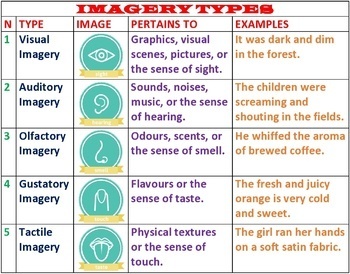

They help in creating empathy for the characters in a narrative. It may be used to convey the sense of texture, temperature, wetness, dryness, and so on. This is used to convey how some things feel when touched. Tactile Imagery is the one that creates a sensory effect of touch through text or the writing of the authors. The smell of fresh rain, the smell of fire are some of the examples of olfactory imagery. It helps in depicting the situation through which the characters of the narrative are going through or experiencing. Olfactory Imagery is the imagery when the author tries to attract the reader’s taste or smell. This may create a sense of gustatory imagery when the readers read about a portion of food. This is generally used to depict the food as the character eats it. Gustatory imagery is the one that appeals to the taste of the readers.

Onomatopoeia is mostly used by authors to create auditory imagery. For instance, creating imageries by author by creating sounds of war in a war novel. Creating auditory imagery through writing is not that easy. Auditory imageryĪuditory Imagery creates an appeal to the reader’s sense of hearing. They generally use metaphor and simile to create visual imagery. Whenever the term imagery is used people understand visual imagery in literature. This is the most common form of imagery that is used in literature. This can include various shapes, sizes, colours, lights, shadows, and patterns.

Visual imagery is the one where the author uses various visual qualities to create imagery. There are seven kinds of imagery that are used in literature. Imagery in Literature (source: Google Images) What are the 7 Types of Imagery in Literature? These are effective devices used by the authors to create these effects. The imagery brings to life the characters of the story through the mental pictures of the readers. They give context for the readers to relate to in a better way. It also helps when the author needs to draw analogies between various related things. They are quite helpful when describing real-life experiences and gives a realistic touch to the story. It allows the readers to paint a beautiful picture and imagine the characters, settings, emotions, and situations in a narrative. The word imagery came from the Old French word “imagerie” which means a figure. The word ‘imagery’ gives rise to the creation of mental images and figures. Imagery is the use of language and symbolism in writing which make our five senses active. It is not only an external feeling but is also an internal feeling which is involved with imagery. This literary device uses an effective creative writing method that evokes the sense of smell, sight, taste, touch, and even internal feeling and emotions. What are the examples of Imagery in Literature?.What are Literary Imagery and Figurative Imagery?.In this lesson on Imagery, we will learn the following. Imagery in literature is a device that uses figurative language which helps the readers to analyze a literary work through their sensory perception and helps creates images to connect with the narrative.


 0 kommentar(er)
0 kommentar(er)
